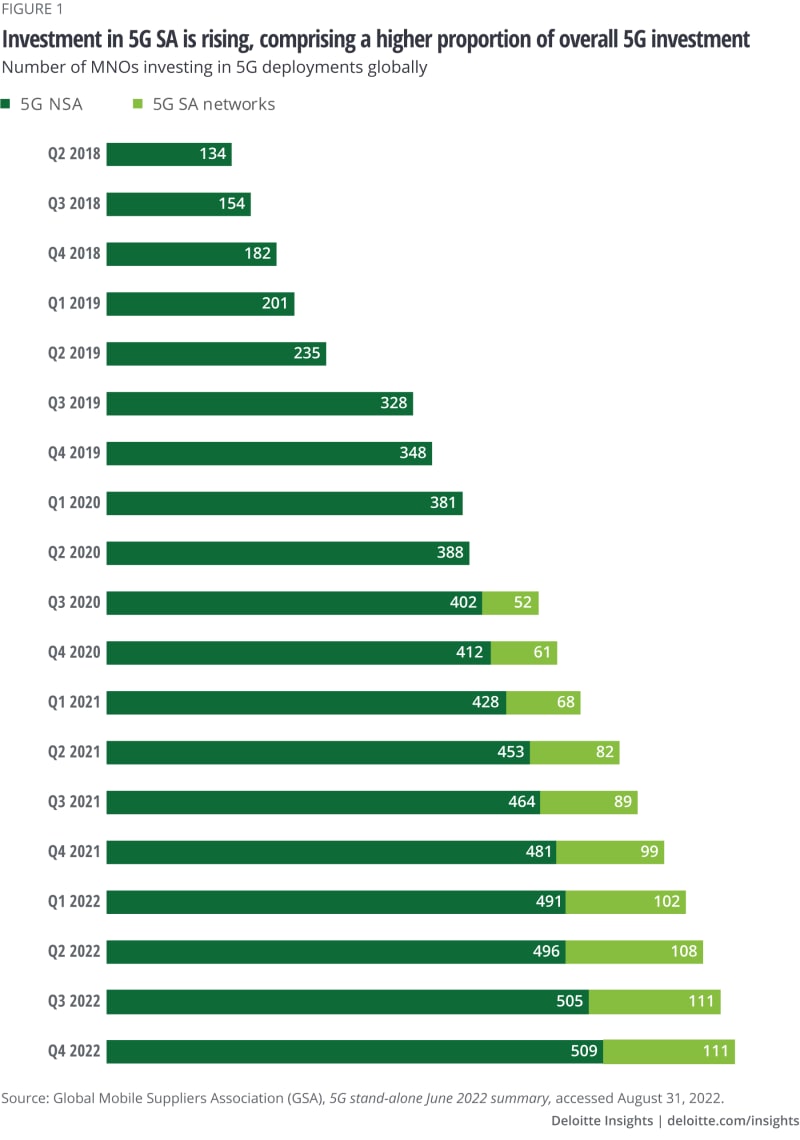- Ultra-reliable, low-latency communication (URLLC), which supports high network reliability and ultra-low latencies of 1 millisecond or less
Ultimately, 5G SA networks could help achieve a unified end-to-end virtualized network architecture with cloud-native orchestration, network functions, and management systems that work consistently from core to edge with carrier-grade quality. This unified platform would offer MNOs many operational benefits, including greater network performance, efficiency, and faster service delivery and innovation cycles.
5G SA’s big attraction for MNOs are the new service and revenue opportunities it creates. Along with near-zero latency and massive device density, 5G SA enables MNOs to provide customers—specifically enterprise customers—access at scale to fiber-like speeds, mission-critical reliability, precise location services, and tailored network slices with guaranteed service levels. Armed with these new capabilities, enterprises can begin exploring a broader range of leading-edge applications and business use cases, possibly including self-driving vehicles; precision robotics; drone inspection and delivery services; and AI-driven security, quality control, and predictive maintenance systems.
Why hasn’t 5G SA become the industry standard already? Because deploying SA networks involves multiple simultaneous initiatives that require close coordination and integration across technology, operational, and organizational domains. 5G SA involves MNOs migrating core networks, essentially the network’s “brains,” from monolithic hardware-centric infrastructure to new, lightweight, modular, virtualized, and cloud-based architectures. To do this, existing networks—including highly complex orchestration, operational, and business support systems as well as network functions—would need to be decomposed, recast, and rewritten into software that can operate in various cloud environments with carrier-grade performance. Moreover, these new core systems would have to fully integrate with other elements of the end-to-end network, including edge radio access networks, which are undergoing their own transformation.
These upgrades involve many critical strategic decisions that can significantly impact future operating and capital costs; business, operating, and organizational models; and potential revenue growth and profitability. For instance, one hotly debated topic is whether MNOs should deploy core networks on public clouds or build and operate their own cloud infrastructure. While private on-premise deployments give MNOs more control, they typically require significant upfront investment and are less scalable. Public clouds offer a ready-built scalable cloud platform but can create challenges in meeting reliability and data privacy requirements. Hybrid approaches may be an option but managing multicloud environments tends to be highly complex.
Another significant hurdle for MNOs may involve transitioning their workforce and methods toward more entrepreneurial, agile, and software-oriented processes needed to operate 5G SA networks effectively. The potentially profound impact of this transition on employee roles and responsibilities, culture and mindsets, and overall ways of working should not be underestimated.
Despite these difficulties, migration to SA seems inevitable. Implementing 5G SA is part of the 3GPP’s3 5G road map, but more importantly, MNOs could be hard-pressed to compete if they don’t. The distinct advantages that MNOs can gain from 5G SA over NSA architectures include:
Reduced complexity and cost. Since SA can support traffic from multiple access technologies, they can effectively converge fixed and wireless, voice and data, consumer and enterprise, or 4G and 5G traffic on a single network, simplifying and reducing the cost of operating multiple networks.
Flexibility and scalability. SA’s cloud-based nature offers MNOs more flexibility to locate and manage core network functions wherever needed to help deliver a great customer experience, whether in the cloud, in multiple clouds, at the network edge, in a private data center, or in some combination. SA networks are also easier to scale, which is important to support the future development of hundreds or even thousands of edge locations arising from the growing trend toward distributed (edge) computing.4
Responsiveness to demand. Many of 5G SA’s new features are possible because it uses a consistent, programmable platform (known as service-based architecture) that enables MNOs to seamlessly manage distributed locations as a single unified network. This allows SA networks to not only scale but also become more elastic to meet changes in demand without necessarily adding more people, hardware, or cost. In other words, SA essentially migrates MNOs from a lumpy capex to a more granular opex spending model.5
New feature development. 5G SA can speed up service delivery and innovation cycles due to its software-based service model as well as its agile continuous innovation and continuous deployment cycles. MNOs can also more easily engage third-party developers to introduce new network functions and features. One promising opportunity is to create more advanced automation tools that utilize big data technologies to reduce network cost and complexity. For example, new AI-driven applications allow SA networks to self-optimize and customize resources in response to changing demand or environmental conditions.6 Further innovations may also lead to fully automated systems, ultimately enabling closed-loop, zero-touch service fulfillment, provisioning, and assurance.
New revenue opportunities. For instance, many view network slicing as a key opportunity for MNOs to expand their addressable market. With network slicing, MNOs can create and manage multiple distinct virtual networks on the same infrastructure and configure each slice to support different service level requirements for specific customer applications.7 This could pave the way for operators to move away from selling simple connectivity solutions to offering more advanced value-added services such as private networks, managed network operations, and tailored privacy and security solutions. MNOs may also choose to open their SA platform to third-party developers (similar to what cloud providers do), thereby fostering the development of potential new applications.

















